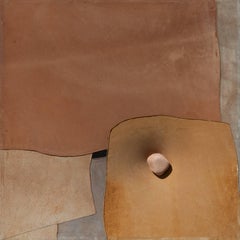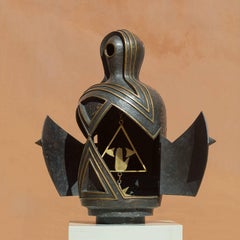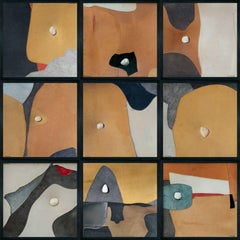Arco Gallery Abstract Sculptures
to
1
1
1
Overall Width
to
Overall Height
to
3
2
1
1
1
1
2
2
2
2
1
3
3
Enchanting - Leather Artwork, Stone Sculpture, Italian Modern Art, Minimalist
By Angelo Canevari
Located in New York, NY
Mirabile by Angelo Canevari is a striking and tactile work that showcases the artist's ability to transform organic materials into a profound statement. Using leather and stone, Cane...
Category
1980s Assemblage Abstract Sculptures
Materials
Stone
Canopo - Bronze Sculpture, Contemporary Sculpture, Geometric Art, Italian artist
By Angelo Canevari
Located in New York, NY
This striking bronze sculpture by Angelo Canevari blends ancient symbolism with contemporary design, making it a captivating centerpiece for any sophisticated interior. The work's ar...
Category
1990s Modern Figurative Sculptures
Materials
Bronze
Enchanted Composition- Leather and Stone Sculpture, Burri and Fontana Inspired
By Angelo Canevari
Located in New York, NY
Angelo Canevari's "Mirabile Composto" is a 106.3 x 106.3-inch leather and stone abstract sculpture composed of 12 elements. This piece is part of a limited number of works where Canevari engaged in a different medium than bronze. The title "Mirabile Composto" comes from a 17th-century quote describing the work of the famous Baroque Italian artist Gian Lorenzo Bernini. It refers to Bernini's fusion of architecture, sculpture, and painting. In this work, Canevari skillfully plays with different shades of leather and a river pebble to blur the distinction between painting, sculpture, or architectural pieces. The piece projects a magnetic presence. It reminds the immensity and peacefulness of the golden sand mounds in the Sahara desert when viewed from an aerial view.
Angelo Canevari is an Italian sculptor from a long lineage of artists active in Rome since the 17th century. He has been commissioned several works by the Vatican, including the Bronze Doors of the Cathedral of Belluno and the Vatican Coins.
Category
1980s Assemblage Abstract Sculptures
Materials
Stone
Related Items
Mid Century Modern Vintage Assemblage Abstract Wall Sculpture Female Artist
Located in Buffalo, NY
Mid Century modern vintage assemblage abstract wall sculpture by Mary Kremer.
Category
1960s Assemblage Abstract Sculptures
Materials
Wood, Acrylic
$1,031 Sale Price
20% Off
H 36 in W 12 in D 7 in
"Couple II" Mid 20th Century Modern Abstract Figurative 1940s European Sculpture
By Jacques Lipchitz
Located in New York, NY
"Couple II" Mid 20th Century Modern Abstract Figurative 1940s European Sculpture
Jacques Lipchitz (1891-1973)
"Couple II"
Bronze
signed on the base
The sculpture was conceived in 19...
Category
1940s Modern Figurative Sculptures
Materials
Bronze
$75,000
H 8 in W 8 in D 5 in
David Hostetler Polished Bronze Female Form Bust Feminine Shiny Gold Egyptian
By David Hostetler
Located in Nantucket, MA
This polished bronze bust is sealed with Glasurit- a car finish that is baked on. It prevents the sculpture from tarnishing or yellowing. All you need to do is dust with a soft cloth. This bust is from a full figure wood sculpture...
Category
1970s Modern Figurative Sculptures
Materials
Bronze
$5,900
H 11.5 in W 7 in D 4 in
Israeli Bronze Sculpture Lovers Embrace Abstract Modernist Ein Hod Israel
By Gedalia Ben Zvi
Located in Surfside, FL
Bronze sculpture signed in Hebrew and numbered from small edition of 6
BIOGRAPHY
"I was born in Czechoslovakia in the year 1925, of traditional parents. I spent my youth partly in ...
Category
Mid-20th Century Modern Figurative Sculptures
Materials
Bronze
$1,800
H 17 in W 10 in D 8.5 in
Hattakitkosol Somchai Art Bronze Bird Sculpture, circa 1980
By Hattakitkosol Somchai
Located in Atlanta, GA
Soar into the realm of timeless artistry with this magnificent gilded bronze sculpture by celebrated Thai artist Hattakitkosol Somchai (1934–2000)—a commanding representation of a bi...
Category
1990s Modern Figurative Sculptures
Materials
Bronze
$1,700
H 16.94 in W 3.94 in D 4.75 in
Bronze Abstract Space Age Book Sculpture LA California Modernist Charna Rickey
By Charna Rickey
Located in Surfside, FL
Charna Rickey 1923 - 2000 Mexican-American Jewish Woman artist.
Signed Bronze House of Books, Architecture Bronze sculpture, signed Charna Rickey and on the front "House of the book." It depicts an open Torah. Original patina.
Approx. dimensions: 7 in. H x 9 in. W x 8.5 in. D. Weight: 13.1 lbs.
Modernist Judaica Sculpture
Born Charna Barsky (Charna Ysabel or Isabel Rickey Barsky) in Chihuahua, Mexico, the future artist lived in Hermosillo and immigrated to Los Angeles when she was 11. She was educated at UCLA and Cal State L.A., she married furniture retailer David Rickey and explored art while raising their three daughters. Moving through phases in terra cotta, bronze, marble and aluminum, she found success later in life. Rickey became one of the original art teachers at Everywoman's Village, a pioneering learning center for women established by three housewives in Van Nuys in 1963. She also taught sculpture at the University of Judaism from 1965 to 1981.
As Rickey became more successful, her sculptures were exhibited in such venues as Artspace Gallery in Woodland Hills and the Courtyard of Century Plaza Towers as part of a 1989 Sculpture Walk produced by the Los Angeles Arts Council. Her sculptures have also found their way into the private collections of such celebrities as Sharon Stone.
Another of Rickey's international creations originally stood at Santa Monica College. In 1985, her 12-foot-high musical sculpture shaped like the Hebrew letter "shin" was moved to the Rubin Academy of Music and Dance at Hebrew University in Jerusalem. The free standing architectural Judaic aluminum work has strings that vibrate in the wind to produce sounds. Rickey also created art pieces for the city of Brea. They commissioned some amazing art pieces by Laddie John Dill, Walter Dusenbery, Woods Davy, Rod Kagan, Pol Bury, Niki de Saint Phalle, Magdalena Abakanowicz, Larry Bell, John Okulick...
Category
20th Century American Modern Abstract Sculptures
Materials
Marble, Bronze
$2,200
H 7 in W 9 in D 8.5 in
Woman Lying Down & Growing with Tree bronze sculpture by Yulla Lipchitz
Located in Hudson, NY
Organic, abstract bronze sculpture by Yulla Lipchitz of a woman lying down with a tree.
About this artist: Yulla Lipchitz, née Halberstadt, was born on April 21, 1911 in Berlin, Ge...
Category
1970s Modern Figurative Sculptures
Materials
Bronze
$3,775
H 16 in W 7 in D 8 in
Latin American Raúl Valdivieso Bronze Organic Abstract Sculpture
By Raúl Valdivieso
Located in Washington, DC
Striking bronze organic sculpture by Latin American sculptor Raúl Valdivieso (Chilean, 1931-1993). Valdivieso is known for his reinterpretation of the ...
Category
1960s Modern Abstract Sculptures
Materials
Bronze
$1,925 Sale Price
30% Off
H 15 in W 12 in D 8 in
Walking Man
By Maxine Kim Stussy 1
Located in West Hollywood, CA
Maxine Kim Stussy, a prolific sculptor and painter from the late 1940’s to present. Maxine led an incredibly artistic life traveling the world with h...
Category
1970s Modern Figurative Sculptures
Materials
Bronze
“Tiny Celadon Green Jacket, ” Steel Sculpture
By Gordon Chandler
Located in Chicago, IL
Upon discovering a weathered steel drum that had been warped to resemble the sleeve of a garment, artist Gordon Chandler was inspired to embark on a series of kimono sculptures formed from found metal scraps. With an eye to the aesthetic possibilities of this humble material, Chandler invests the reclaimed steel with sculptural fluidity and a wry sense of form.
Flattened with the center portion rolled out and the sides left open, this discarded barrel takes on the look of a miniature jacket. Coated with a mint green finish, the eroded metal appears as draped fabric, folded back to form a simple collar. The sculpture is finished with the artist's initials stamped...
Category
2010s Modern Abstract Sculptures
Materials
Steel
"Draped Figure" Sassafras & Bronze, Figurative Sculpture, 1982
Located in Detroit, MI
"Draped Figure" is a beautiful example of Tazian's ability to meld the smooth texture of wood and the hard texture of bronze into an exquisite object to view, hold or caress. The piece balances perfectly on its stone base and can be easily turned to enjoy from all angles.
Like architects Eliel Saarinan and Albert Kahn and sculptor Corrado Parducci, Tazian is an immigrant creative who has found a home in the city, nurtured by its energy and sheltered by its community.
He developed an early ambition to become an artist, even though he had very little exposure to the arts. ““The only person [who encouraged me] was my 5th grade English teacher, Olivia Balian,” he says. “She really opened the doors of art for me. She said, ‘Those students who are interested in art can stay behind after school and I will show you how to paint and draw.’ Somehow [that] changed my life– she gave me that spark.”
Tazian came to the U.S. to study at St. Francis College in Fort Wayne, Indiana. He earned a bachelor’s degree in art and a Master’s in Art Education, and then earned and MFA in sculpture from Wayne State University in Detroit.
Kegham Tazian is an award-winning sculptor and painter. The Armenian-born artist has gained notoriety for the diversity of his work and the variety of media exemplified in his pieces. A blend of modernism, realism and abstraction are commonly depicted in his paintings and sculptures.
His artwork has been represented in more than 40 solo exhibitions and more than 75 group exhibitions throughout the United States, Canada, Europe, and the Middle East. His work adorns the entrances and halls of major corporations, universities and municipalities, including Siemens Corporation, Huntington Bank, Wayne State University and the city halls of Farmington and Farmington Hills...
Category
21st Century and Contemporary Modern Abstract Sculptures
Materials
Stone, Bronze
$5,200
H 25 in W 4 in D 4 in
Bronze Heron Sculpture by Wayne F Williams
Located in Rochester, NY
Bronze heron by American sculptor Wayne Williams. Signed and dated 1993. Edition 2/2. Mounted on a walnut base.
From Finger Lakes Magazine 2001:
Art is everywhere in the Finger Lakes. Inspired by the region’s diverse scenery and lifestyles, artists pursue their creativity outdoors, in studios and in workshops. In the many well-established museums and galleries or at the newer fledgling arts organizations, a wide array of artistic styles and talents are represented. Often the artists, like Wayne Williams, share their artistic skill and passion through teaching at local colleges.
Williams, who is retired after a 35-year career at Finger Lakes Community College, found his calling there. “I didn’t want to teach in public schools,” explains Williams of his career choice. “I wanted to be at the college level. CCFL (the Community College of the Finger Lakes, as it was then known) was literally creating a college, right from scratch.” The year was 1968 and Williams was charged with coordinating the new college’s art program.
Rand Darrow, a CCFL student in that first year, remembers attending Williams’ art classes in a commercial building on Main Street just south of the railroad tracks in Canandaigua. Darrow appreciated his instructor’s relaxed manner. “He was a great teacher,” recalls Darrow, “cracking jokes all the time.” Darrow graduated with a major in Liberal Arts and continued on to SUNY Oswego where he earned a BA in fine arts. He taught art to elementary and middle school students for 30 years.
These days Williams and Darrow typically cross paths at the Wayne County Arts Council in Newark where Williams and his wife, Marleen, are heavily involved. Williams offers classes in figure drawing and sculpture and hangs the gallery’s shows, including his former student’s “Slavic Tales of Novgorod” this past August. “I’d like to take a sculpture class from him,” says Darrow.
In 2003 when Williams retired, the college honored him and another retiring art professor, Tom Insalaco, by renaming its art gallery the Williams-Insalaco Art Gallery. It was known formerly as Gallery 34 to recognize its origins at 34 North Main Street in Canandaigua. Williams held professor’s rank from 1976 and served as director of the art gallery beginning with its opening in 1983.
Williams, who was born and raised in Newark, New York, says he began doing art at about age 8. By the time he was in junior high school his career direction seemed clear. He received local and national awards for his art and a scholarship to Syracuse University, from which he graduated in 1958 with a Bachelor of Fine Arts in sculpture. He continued with graduate work at Syracuse, receiving an MFA in sculpture in 1962. He worked full time as a sculptor until he began teaching.
At one point Williams admits he wanted to be a painter, but didn’t want to adopt the abstract expressionist style in vogue in the 1950s, preferring to pursue the realist tradition. He advises any would-be artist to “do what you do because you love it.”
After graduation he traveled abroad, spending time in Belgium, the land of his ancestors. “My family’s name was originally Willems,” explains the 73-year old who still relishes the time spent in the Flemish countryside. Williams speaks excitedly about art, referencing the lives of great artists. He acknowledges that American artists do not have the same stature as those in Europe, where Old Masters like Brueghel and Rembrandt are national heroes.
These days the energetic Williams, known primarily as a sculptor, is active at the Phelps Arts Center where he is on the board of directors. In mid-September when a group of visitors on a motor coach tour explored artworks displayed in the beautiful church-turned- gallery, they were treated to a large number of Williams’ bronze and metal sculptures, along with his charcoal drawings. “I’ve always loved his work because he deals with things, people, and animals you understand,” says the center’s Director Emeritus Marion Donnelly, who has known him for many years.
Outside the Phelps Community Historical Society, Williams’ life-size figure of a farmer raises his pitchfork above a colorful flower garden on the front lawn. Inspired by the peasants working the fields in Europe, the metal figure is shown with wooden shoes. This is Williams’ largest copper piece, loaned to the Phelps museum in connection with Artistry in Sculpture, a community exhibition in 2009. Williams added a new base using a metal wagon...
Category
20th Century Modern Figurative Sculptures
Materials
Bronze


